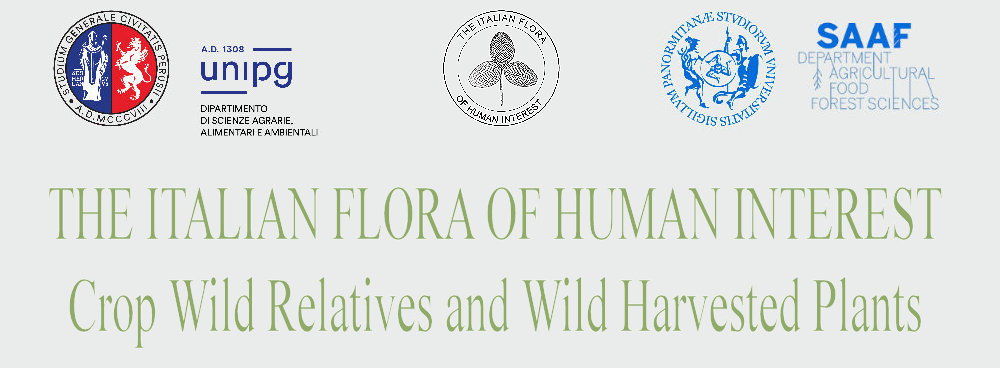
| Description of attributes provided in the checklist for each taxon and main bibliographic sources. These attributes were used as criteria for the identification of CWR and WHP in Italy and for the prioritization process. | |||
| Inventory information | Fields | Explanation | Main sources of information |
| Crop Wild Relatives and Wild Harvested Plants | CWR, WHP | Whether the taxon is a CWR (species of the same genus or related with cultivated plants) or a WHP (wild species harvested for utility indipendently by actual economic importance). | CWR (as defined by Maxted et al. 2006 and refs. therein) and WHP (as defined by Magos Brehm et al. 2008) were deducted on the basis of the information mentioned below and following the Crop Wild Relative Catalogue for Europe and Mediterranean (Kell et al. 2005, 2008) and Landucci et al. 2014. |
| Main taxonomic information | Family, Genus, SpeciesEpi, InfraSpeciesEpi, FullNameCache, Rank, Synonym | Taxonomic information including higher ranks (family and genus), specific, infraspecific names and synonyms. | Bartolucci et al. (2018); Euro+Med (2006-): Euro+Med PlantBase. http://ww2.bgbm.org/EuroPlusMed/ [accessed September 2019]; Galasso at al. (2018); Pignatti et al. (2017-2019); The Plant List. TPL - http://www.theplantlist.org/; IPNI. International Plant Names Index - http://www.ipni.org/ (accessed July 2019); |
| Status and distribution | Unit, StatusUnknown, Native, Introduced, Cultivated, Large-scale cultivation, WorldDistCompl, Archeo/Neo, Endemism | Native, cultivated, introduced, archaeophytes (introduced before 1500s), neophytes (introduced after 1500s), endemic | anArchive - http://www.anarchive.it/ [accessed December 2019]; Bartolucci et al. (2018); Celesti-Grapow (2009); Conti et al. (2005, 2007), CWR Catalogue for European and Mediterranean (Kell et al. 2005, 2008); Euro+Med (2006-): Euro+Med PlantBase. http://ww2.bgbm.org/EuroPlusMed/ [accessed September 2019]; Galasso at al. (2018). |
| Genetic relationship with the crop: Gene Pool (GP) | GP1A, GP1B, GP2, GP3 | GP1A (cultivated form), GP1B (wild or weedy forms of the crop), GP2 (less closely related species with the crop) and GP3 (species not closely related with the crop). In database GP are reported in the same order of "Cultivated plant related" | Harlan and de Wet (1971). Crop Wild Relatives and Climate Change (2012) http://www.cwrdiversity.org/checklist/ [accessed on 08-2019]; Germplasm Resources Information Network - (GRIN), http://www.ars-grin.gov/cgi-bin/npgs/html/index.pl [accessed on 08-2019]; Vincent et al. 2013. |
| Genetic relationship with the crop: Taxon Group (TG) | TG1A, TG1B, TG2, TG3, TG4, TG5 | TG1A (cultivated crop taxa), TG1B (taxa within the same species as the crop), TG2 (taxa within the same series or section as the crop), TG3 (taxa within the same subgenus as the crop), TG4 (taxa within the same genus as the crop), TG5 (taxa within the same tribe as the crop) | Maxted et al. 2006. |
| Uses | Uses | These categories include food, fodder, drink, food additive, honey production, environmental, ornamental, material, fuel, medicine, folk medicine, poison, social, gene source, ethnobotanical. The use was recorded only whenever information were available. | Germplasm Resources Information Network - (GRIN), http://www.ars-grin.gov/cgi-bin/npgs/html/index.pl [accessed on 08-2019]; Hanelt & Institute of Plant Genetics and Crop Plant Research (2001), electronic version: IPK Gatersleben - http://mansfeld.ipk-gatersleben.de/. Further information were estracted from national literature sources: Atzei et al. 1994; Atzei 2003; Leporatti et al. 1985; Leporatti and Pavesi 1989; Manzi 1999, 2003; Pieroni 2000; Pieroni and Quave 2005; Arrigoni 2006; Ghirardini et al. 2007; Pieroni and Giusti 2009; Arrigoni 2010a, 2010b; La Mantia et al. 2011; Arrigoni 2013; Schicchi and Geraci 2015; Guarrera and Savo 2016; Biscotti et al. 2018; Geraci et al. 2018; Pasta et al. 2020. |
| Protection degree | Orsenigo et al., 2020; Orsenigo et al., 2018, Rossi et al., 2016; IUCN Red List of Threatened Species. | Whether the taxon is under protection (or was under protection) for the National and International Red Lists. The threatened status is indicated by the IUCN categories. | IUCN Red List of Threatened Species (IUCN 2020), http://www.iucnredlist.org [accessed 05-2020]; Orsenigo et al. 2020; Orsenigo et al. 2018; Rossi et al. 2016. |
| Priority | ITPGRFA Annex I, ISTAT, Priority | Whether the taxon is considered priority because relative to a crop included in the Annex I of the International Treaty on Plant Genetic Resources for Food and Agriculture and/or in the list of the crops with highest economic value in Italy according to the National Institute of Statistic and/or because its limitate distribution and/or conservation status. | International Treaty on Plant Genetic Resources for Food and Agriculture (ITPGRFA, FAO 2009 - http://www.planttreaty.org [accessed on 08-2019]); ISTAT (2012) - http://agri.istat.it [accessed on 08-2019]. |



